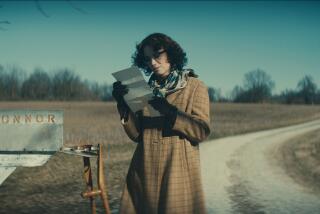Bound by blood and old wounds
- Share via
WERE it not for the fact that “The Light of Evening” is her 20th book, it would be impossible to credit the equally undeniable fact that Edna O’Brien will turn 76 this December.
Her fiction remains so vital and engaged, so contemptuous of piety and convention, so hostile to sentiment and so willing to risk real feeling that it sometimes seems as if the author must have sprung from one of those islands of eternal youth and beauty with which Irish mythology dotted the seas west of her native County Clare. But because she did not, we have now a shelf-ful of novels and story collections that constitute one of the scant handful of careers in English-speaking letters that unquestionably deserves to be called great.
“The Light of Evening” surely cements that appraisal. One of the things that distinguishes O’Brien’s recent work is not only the way in which she remains so shrewdly attentive to the nuances of the current situation, but also the manner in which her always formidable technical facility continues to deepen. This latest novel combines elements of the epistolary novel, stream of consciousness, historical fiction and the cinematic into a seamless whole that fully merits the adjective “bravura.” Perhaps more striking, a prose that always has been marked by its palpable sensuality has somehow taken on a wise and authentic lyricism as well. Take these two sentences toward the story’s end that describe a funeral cortege proceeding out of Dublin:
“The wet green world into which the rain has poured and now sunshine lighting upon everything, fields of grass a pulsing green and rivers overflowing, swishing the shores, black-green at the bends, branches forking this way and that and where the odd leaf had clung on, brown and hunched like brown hunched birds, yet the crows swooping and joyous, the rained-on roads drying out, ranges of mountains in the distance a molded blue, at one with the horizon.
“Bringing her home to the woodlands she knew.”
The home-comer is Dilly, mother to Eleanora. The two of them are the story’s protagonists and their fraught and passionately estranged attachment is the novel’s subject. Since Turgenev, our literature has made much of the problem of fathers and sons, but as O’Brien so heartbreakingly demonstrates in this book, it can’t hold a candle to what passes between mothers and daughters.
The 78-year-old Dilly is dying of cancer in a Dublin nursing home, awaiting one of the annual visits from her daughter, a famous writer who has lived abroad since her marriage to a foreigner of whom her mother disapproved. Letters, alternately hilarious and emotionally rending, flow from Dilly through the years; gifts and grudging visits come from Eleanora. As she awaits the daughter’s final visit, Dilly recalls her own life -- a stunningly evoked period as a servant in New York in the 1920s, a failed romance and return to Ireland.
There is marriage to an alcoholic horse trainer and life in a beloved but faded old house and farm called Rusheen. There is an unquenchable love and unbridgeable estrangement from Eleanora, author of a sensual novel that creates local scandal. (Both mother and daughter have been unfortunate in love.) Finally, Eleanora arrives, but things go badly and she departs -- flees is not too strong a word -- in haste, inadvertently leaving behind, in a bag, a secret journal she has kept of her own relationship with Dilly.
The events surrounding Eleanora’s recovery of that diary after Dilly’s death -- of heart failure, as more than one character is at pains to point out -- and her realization that her mother has read it, set in motion a conclusion that is, at once, shocking and emotionally just right. Suffice to say that, in a fashion entirely Irish, Rusheen is at the center of things.
Those familiar with the details of O’Brien’s own life are bound to see convergence here.
Eleanora’s experience, of course, mirrors the author’s own with her novel -- the first in what became the celebrated “Country Girls Trilogy” -- which was banned by the Irish censors and burned in her home parish. As O’Brien has said elsewhere on the link between life and work: “It is as if the life lived has not been lived until it is set down in this unconscious sequence of words.”
Moreover, this is a writer whose commitment to literature began with a reading of “A Portrait of the Artist as a Young Man.”
As she subsequently has written about Joyce, he “once said that as we go through life we meet a dastardly crew of ghosts, robbers, highwaymen -- but ultimately we meet ourselves.”
Like Joyce, O’Brien met initial communal rejection with exile and she has long lived in London, where -- divorced from her Irish-Czech-Jewish husband -- she wrote and raised two sons. Ireland, however, has remained her constant subject and her eye for the country’s contemporary realities remains spot on.
In this novel, there is a wonderfully apt interlude with a Latvian serving girl, when Dilly’s funeral cortege pauses for tea: From Dublin to Limerick, Irish service workers now are overwhelmingly Eastern European immigrants.
It’s not for nothing, though -- nor even for art’s sake -- that Irish writers retain their iron memories. The county library in O’Brien’s native Clare maintains a website with a category called “Clare People.” Here’s the entry for Edna O’Brien:
“Edna O’Brien was born on December 15, 1930, in Tuamgraney, County Clare. She was educated at the National School in Scariff, the Convent of Mercy at Loughrea, and the Pharmaceutical College in Dublin. She married Ernest Gebler in 1951, but the marriage was dissolved in 1964. She has two sons, Carlos and Sasha.
“County Clare remains so much in O’Brien’s veins that the people there continue to find themselves in her works; of these a dominant figure has been a mother or several mothers (Mrs. O’Brien died in spring 1977). The content of her work has also been coloured by Irish lore and history and by distinctive geographic features such as Druids’ circles and the Holy island (Inis Cealtra) in Lough Derg. In 1959 O’Brien moved to London, where she maintains residence, but she often returns to Ireland.”
It was not for nothing that Yeats sang:
To cold Clare rock and Galway rock and thorn,
To that stern color and that delicate line
That are our secret discipline....
At the end of the day, “The Light of Evening” shines elegiacally not only on the relationships between mothers and daughters, but also on exile and abiding, on the frequently wrenching conflicts between the lives and people to which we are born and those we choose for ourselves and upon the inevitable inversions that time brings to parents and their children.
The late Irish poet Micheal O hAirtneada once recalled his father’s wake in verse and, walking into the room where the open coffin stood, peered in and thought:
He was no longer my father
But I was still his son.
“God enters through a wound,” wrote Patrick Kavanagh and, in “The Light of Evening,” O’Brien lyrically suggests the possibility of a similarly luminous and reconciling presence, when the lacerating embrace between daughters and their mothers dissolves.
*
The Light of Evening
A Novel
Edna O’Brien
Houghton Mifflin: 304 pp., $25
More to Read
Sign up for our Book Club newsletter
Get the latest news, events and more from the Los Angeles Times Book Club, and help us get L.A. reading and talking.
You may occasionally receive promotional content from the Los Angeles Times.








